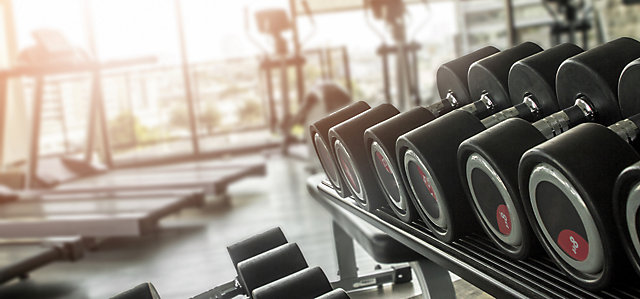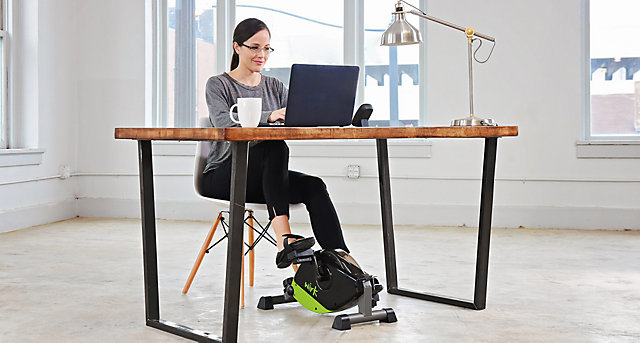
Keeping fit at the office
Creating a company gym
Healthy employees are worth the effort. That’s why more and more companies are investing in keeping their staff fit, whether through partnerships with commercial gyms or by providing gym facilities within the company.
Here, we look at
- the economic advantages of providing staff with opportunities to keep fit,
- the different approaches,
- how to create a fitness area at your company.
Why helping staff to keep fit is worth it
Exercise used to be something you only did outside of work, but this has changed – and not (only) because companies want to keep their employees happy.
Employers who provide their staff with keep-fit opportunities benefit on a number of levels:
Fewer sick days
Back pain is one of the most common reasons for employees to be written off sick. A major cause of this is the sedentary nature of many jobs: we spend hours sitting at desks and getingt little exercise. If you give your staff the opportunity to get moving during their working day, they stay fit, healthy and capable of working for longer, and take less time off.
Improved performance
Healthy employees are generally more efficient than those who are suffering with chronic pain or restricted mobility. This doesn’t only apply to physical jobs – people with desk jobs can concentrate better when they are moving regularly to stimulate circulation and are not experiencing complaints such as back problems.
More satisfaction
Exercise boosts mood and helps people to cope with work stress. Which is why company keep-fit opportunities help staff to enjoy being at work and make them less likely to feel overwhelmed.
Incentives for attracting highly qualified staff
Offering health and fitness opportunities such as a company gym will make a good impression when you are looking to recruit sought-after specialists. Because prospective staff aren’t just concerned about salary – they want other perks too. And they won’t be tempted by an occupational health strategy that is limited to the odd fruit bowl at a meeting. On the other hand, a company gym where they can work out for free could tip the balance in your favour. Providing health and fitness perks also helps to keep existing qualified staff on board.
Three concepts for corporate fitness

Partnerships with commercial gyms
Employers often subsidise the costs of gym memberships for their employees, who can then use a particular gym (or chain of gyms) for less, or even for free. Many gyms have attractive deals for partnerships of this kind, and may even offer programmes that are tailored to individual companies. The downside: staff have to motivate themselves to take advantage of this opportunity. You as their employer have little influence on whether they actually go to the gym or not. The same applies to partnerships with adult education institutions and yoga studios. It can end up being the case that only a fraction of staff are actually making use of what’s on offer.

Company sport
Company sport – for example group runs after work or cycling trips – is a way of boosting team spirit. However, it often tends to be quite one-sided, perhaps limited only to running, and those who are not naturally sporty don’t feel it is for them. In addition, the organisation takes up a lot of time. As a result, these sorts of activities don’t usually result in effective exercise programmes.

Company gyms
More and more companies are opting for a gym on their own premises. This has the advantage that you as an employer have complete control. You can set up your gym so that it is appealing for different groups within your workforce and meets the particular needs of your company. A small room is usually all you need, which you then kit out accordingly. Your staff will then be able to get a quick work out in either before or after work.
Gym equipment for companies – Check list
- Clarify individual requirements
Think about your staff: how many of them are sporty? What is the age structure like? How many people are there with pre-existing conditions? Are there particular types of physical strain associated with the work your company does?
- A variety of training options
Ideally, your staff will be able to work out in a variety of ways, improving strength, endurance and coordination. You might also want to consider offering yoga classes with a trained instructor. The more employees you can get involved, the better.
- Ergonomic, easy-to-use equipment
Fitness apparatus should be easy to operate for beginners and have a low risk of injury. Basic gym equipment includes a cross trainer, rowing machine, running machine and ergometer as well as strength training equipment for larger muscle groups. If you have a number of employees who have experience with strength training, consider having an additional area for free weight training.
- Professional instruction
It is essential to provide professional instruction on how to use fitness equipment. Perhaps you have the option of training some of your employees so that they can fulfil this role of trainer, or maybe you prefer to bring in someone from outside. When choosing training apparatus, make sure to check that it is of high quality and has the necessary certification mark. Otherwise, your efforts to increase occupational health and safety could have the opposite effect.
- Pleasant atmosphere
If people are going to use your company gym, it needs to be a space where they feel comfortable. You can achieve this by putting in a joint-friendly floor, large mirrors for those working out to check they are doing the exercises correctly, and lighting that creates a good ambience. Maybe you also have space for sanitary facilities and/or a shower.
Working out at work – here’s how it’s done

Getting fit whilst working at your desk? Why not! Start with height-adjustable desks. These allow staff to switch back and forth between standing and sitting, which strengthens the back and legs and gets circulation going.
Or you can go a step further and get fitness apparatus for desks. A desk bike can be used in place of a chair, for example. This allows users to slowly pedal as they work, boosting their endurance whilst getting their work done. Similar options include mini bikes and mini ellipticals, which are designed to fit under desks.
Fitness apparatus of this kind doesn’t replace going to the gym, but it can be a valuable addition to it, helping prevent typical office health complaints such as headaches, tiredness and tense muscles without the user even having to get up from their desk.
Overview of our fitness products:
Contact us!
We are available to answer any other questions, free of charge.


